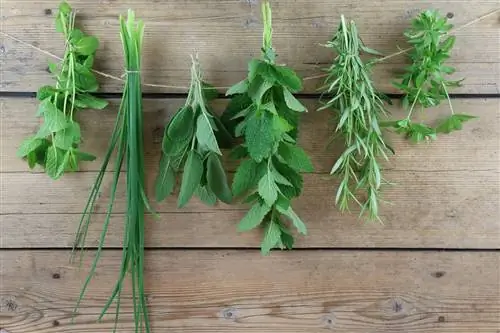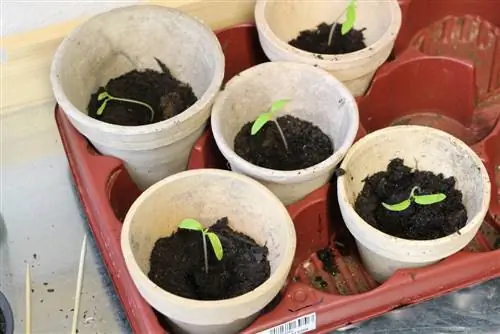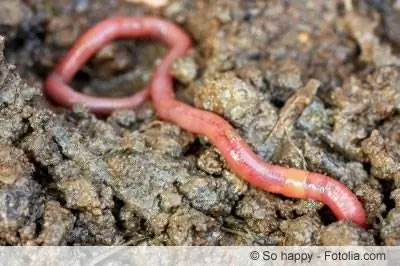- Author admin [email protected].
- Public 2023-12-17 03:39.
- Last modified 2025-06-01 06:48.
Minor accidents can happen quickly, be it at home or on the go. How good it is to have the right ointment at hand. You can of course buy them at the pharmacy or easily make them yourself with the right ingredients. The fresh leaves can be collected from your home garden or from nature. If stored appropriately, the ointment has a relatively long shelf life.
Collecting comfrey leaves
With a herbal ointment, the fat-soluble active ingredients of the herbs are transferred into the ointment, which ultimately determines its effectiveness. If you want to make your own ointment from comfrey leaves, you can use dried leaves from the pharmacy or collect fresh ones from April to October. When collecting, confusion with those of the non-poisonous, edible borage and especially with the highly poisonous foxglove should be avoided. But foxglove and comfrey in particular have key distinguishing features.
- Significant differences in size, leaves and flowers
- Foxglove up to 200 cm tall
- Foxglove leaves velvety-smooth
- Leaf edges have small irregular notches
- Flowers in long clusters
- Large bell-shaped flowers
- Individual flowers all hang on the same side
- Comfrey plant 30-100 cm tall
- Leaves large, protruding and rough to bristly hairy
- Leaves and stems, rubbed between fingers, smell like cucumber
- Flowers of the comfrey plant curled up and hanging downwards
- Also bell-shaped but significantly smaller
Tip:
The effect of comfrey leaves is not as intense as that of the root. That's why ointments are primarily made from the roots.
What else is needed
Basically, both the leaves and the roots can be used to make the ointment, with the roots having a stronger effect. In addition to the fresh leaves, so-called carrier materials are also required for the ointment. These include a good vegetable oil or lard, beeswax and lanolin (wool wax) or shea butter.

Instead of pure oil, you can also make an ointment using a cold or hot extract that you can make yourself, although this is a little more complicated. Remains of these extracts can be filled into dark bottles and stored for later creams and ointments. Once the ointment is ready, fill it into small, closable and opaque jars, cream jars or other suitable containers.
Tip:
Forage comfrey (Symphytum x uplandicum) is often used for commercial ointments. For private use, common or common comfrey (Symphytum officinale) is usually used.
Make your own comfrey ointment - instructions
There are various methods for making your own ointment from comfrey.
Vegetable oil and beeswax
You need 120 g dried or 300 g fresh, finely chopped comfrey leaves as well as 500 ml olive oil and 60 g beeswax. Instead of beeswax, pure lanolin without water content can also be used. This is a little more expensive, but it makes the ointment creamier and easier to spread. Lanolin also has an additional healing effect.
- First put oil and beeswax in a heatproof container
- Heat the whole thing slightly and let it melt
- Too much heat can destroy active ingredients
- It's best to do a consistency test afterwards
- Add wax or oil as needed
- Then add comfrey leaves
- Cover the container and let it rest for about 10 minutes
- Now filter the slightly cooled mixture through a cotton cloth
- Pour the finished, warm ointment into small, sealable jars
- Let cool completely and close
If you want to make your own ointment from oil and beeswax, the most important thing is the correct mixing ratio of these two ingredients. This ultimately determines how solid the ointment becomes. It's best to test the consistency in the meantime by putting a small amount on a small plate and letting it cool. If the consistency is too soft, you can add a little more beeswax; if it is too firm, a little more oil.
Tip:
Sensitive people may have an allergic reaction to lanolin. You should use shea butter infused with essential oils instead.
Cold or hot extraction
Another method of making comfrey ointment is using oil extract, which you can easily make yourself. This has the advantage that the active ingredients of the plant accumulate in the oil before the ointment is actually produced and are therefore in higher doses. A distinction is made between a cold and a hot extraction process.
Cold release
A cold extract is a very gentle but somewhat tedious method. First, fill a sealable jar completely with cleaned comfrey leaves. Then fill with oil so that the leaves are completely covered. The jar is closed tightly and placed in a sunny place for about a month. During this time you should shake the jar vigorously once a day. After a month, the oil can be strained and used to make ointments or filled into dark containers for later.
Tip:
If the oil is to be stored for a long time, it is advisable to add some essential oil to prevent it from going rancid.
Hot Excerpt
Hot extraction is the faster method. To do this, heat the oil, but not too much, and add the fresh or dried herbs in the appropriate quantities. The whole thing is then left to simmer gently for about half an hour. The herbs should not be fried, but rather heated as gently as possible. Then let the oil cool down. It can be immediately processed into an ointment or bottled as with cold extraction and stored appropriately.
Avoidable errors when making ointment
If you want to make herbal ointments yourself, you should pay close attention to cleanliness. This applies to the containers and cookware used as well as the work surface. Neither dirt nor detergent residue should stick to it.
- It is best to clean and disinfect pots, pans and work surfaces with alcohol
- Then rub dry with a kitchen towel, not with the tea towel
- Dishwashing sponges and tea towels, breeding grounds for bacteria and germs
- Ointment would mold and become unusable
- Allow the warm mixture to cool completely before sealing
- Otherwise condensation will form under the lid
- Moisture is also a breeding ground for mold

If the ointment has small lumps after it has hardened, you can warm it again in a water bath. Stir them with a glass or wooden stick until you get a homogeneous mass.
Durability and storage
Comfrey ointment is a healing ointment and not a care cream. Accordingly, their shelf life is limited. This makes expert preparation, the use of high-quality ingredients and correct storage all the more important. It is advisable to always use a so-called spatula to remove the ointment.
If you put your fingers into the ointment jars or cans, it encourages the formation of germs, which happens every time you open them. Otherwise, you should only use opaque containers when filling the ointment. If you take these things into account and store the ointment in a cool, dark place, it can be effective for up to a year.be durable. At room temperature it can only be used for a maximum of half as long.
Ingredients and effects of comfrey
The name says it all with this plant, because it is especially good for the legs. An ointment made from comfrey is only suitable for external use. Healing ingredients include allantonin, tannins and mucilage as well as saponins. These substances, especially allantonin, have an anti-inflammatory, pain-relieving and decongestant effect.
Comfrey ointment is primarily used for injuries to the musculoskeletal system, such as sprains, swelling, bruises, joint pain and broken bones. Since this plant contains traces of pyrrolizidine alkaloids, the ointment should not be used on broken skin.






